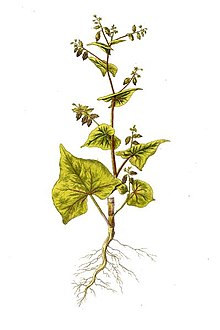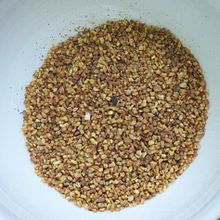bio.wikisort.org - Plant
Fagopyrum tataricum, also known as Tartary buckwheat,[2] green buckwheat,[3] ku qiao,[3] Tatar buckwheat,[citation needed] or bitter buckwheat,[4] is a domesticated food plant in the genus Fagopyrum in the family Polygonaceae.[5][6][7] With another species in the same genus, common buckwheat, it is often counted as a cereal, but the buckwheats are not closely related to true cereals.
| Tartary buckwheat | |
|---|---|
 | |
| Scientific classification | |
| Kingdom: | Plantae |
| Clade: | Tracheophytes |
| Clade: | Angiosperms |
| Clade: | Eudicots |
| Order: | Caryophyllales |
| Family: | Polygonaceae |
| Genus: | Fagopyrum |
| Species: | F. tataricum |
| Binomial name | |
| Fagopyrum tataricum | |
| Synonyms[1] | |
| |
Tartary buckwheat is more bitter and contains more rutin than common buckwheat. It also contains other bioactive components such as flavonoids, phenolic acids,[8] 2-hydroxybenzylamine and quercitrin.[9]
Tartary buckwheat was domesticated in East Asia and is also cultivated in Europe and North America.[10] While it is an unfamiliar food in the West, it is common in the Himalayan region today, as well as other regions in Southwest China such as Sichuan province.[citation needed]

The plant has been cultivated in many parts of the world; however, when found among other crops it is considered a weed.[11][12]

Chemistry
Fagopyrum tataricum contains aromatic substances. The most important difference when compared to the aroma of Fagopyrum esculentum is the absence of salicylaldehyde and presence of naphthalene.[13]
References
- "The Plant List: A Working Checklist of all Plant Species".
- USDA, NRCS (n.d.). "Fagopyrum tataricum". The PLANTS Database (plants.usda.gov). Greensboro, North Carolina: National Plant Data Team. Retrieved 19 January 2016.
- "Fagopyrum tataricum". Germplasm Resources Information Network (GRIN). Agricultural Research Service (ARS), United States Department of Agriculture (USDA). Retrieved 21 December 2017.
- Report of a Network Coordinating Group on Minor Crops. Bioversity International. pp. 65–66. GGKEY:J811QDJNL4H.
- Wang Y, Nie Z, Ma T (2022-02-24). "The Effects of Plasma-Activated Water Treatment on the Growth of Tartary Buckwheat Sprouts". Frontiers in Nutrition. 9: 849615. doi:10.3389/fnut.2022.849615. PMC 8908094. PMID 35284468.
- Zou L, Wu D, Ren G, Hu Y, Peng L, Zhao J, et al. (July 2021). "Bioactive compounds, health benefits, and industrial applications of Tartary buckwheat (Fagopyrum tataricum)". Critical Reviews in Food Science and Nutrition: 1–17. doi:10.1080/10408398.2021.1952161. PMID 34278850. S2CID 236091952.
- Wang Y, Nie Z, Ma T (2022). "The Effects of Plasma-Activated Water Treatment on the Growth of Tartary Buckwheat Sprouts". Frontiers in Nutrition. 9: 849615. doi:10.3389/fnut.2022.849615. PMC 8908094. PMID 35284468.
- Zou L, Wu D, Ren G, Hu Y, Peng L, Zhao J, et al. (July 2021). "Bioactive compounds, health benefits, and industrial applications of Tartary buckwheat (Fagopyrum tataricum)". Critical Reviews in Food Science and Nutrition: 1–17. doi:10.1080/10408398.2021.1952161. PMID 34278850. S2CID 236091952.
- Fabjan N, Rode J, Kosir IJ, Wang Z, Zhang Z, Kreft I (October 2003). "Tartary buckwheat (Fagopyrum tataricum Gaertn.) as a source of dietary rutin and quercitrin". Journal of Agricultural and Food Chemistry. 51 (22): 6452–6455. doi:10.1021/jf034543e. PMID 14558761.
- Anjen L, Hong SP (2004). "Fagopyrum tataricum". Flora of China. Vol. 5.
- "Interactive Agricultural Ecology Atlas of Russia and Neighbouring Countries". Retrieved 16 December 2014.
- Sharma MP (1986). "The Biology Of Canadian Weeds: 74. Fagopyrum tataricum (L.) Gaertn". Canadian Journal of Plant Science. 66 (2): 381–393. doi:10.4141/cjps86-052.
- Janeš D, Prosen H, Kreft S (July 2012). "Identification and quantification of aroma compounds of tartary buckwheat (Fagopyrum tataricum Gaertn.) and some of its milling fractions". Journal of Food Science. 77 (7): C746–C751. doi:10.1111/j.1750-3841.2012.02778.x. PMID 22757696.
External links
 Media related to Fagopyrum tataricum at Wikimedia Commons
Media related to Fagopyrum tataricum at Wikimedia Commons
На других языках
- [en] Fagopyrum tataricum
[ru] Гречиха татарская
Гречи́ха тата́рская (лат. Fagopýrum tatáricum) — вид травянистых растений рода Гречиха (Fagopyrum) семейства Гречишные (Polygonaceae), яровой однолетник, морфологически и биологически очень сходный с культурной гречихой[2].Другой контент может иметь иную лицензию. Перед использованием материалов сайта WikiSort.org внимательно изучите правила лицензирования конкретных элементов наполнения сайта.
WikiSort.org - проект по пересортировке и дополнению контента Википедии